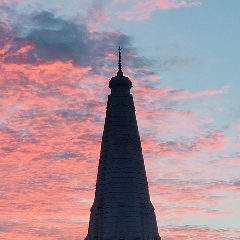Question 1 :
According to the law of reflection of light, the incident ray, the normal at the point of incidence and the reflected ray all lie in one plane. Is it true or false?
Question 4 :
The phenomenon of return of light in the same medium after striking a surface is called
Question 5 :
What type lens is used for a person suffering from short slightness?
Question 6 :
For a people whose both long and short sight ness have, which type of lens is used for distinct vision?
Question 7 :
In visible light which colour light has maximum deviation when passing through a prism?
Question 8 :
What is the relation between wavelength ({tex}\lambda{/tex} ), velocity (V) and frequency (f)?
Question 9 :
What happened during refraction when a light is travelled from rare medium to denser medium?
Question 16 :
If the medium of both side of the lens are same then the focal lengths of the lens are numerically same. Is the statement true or false?
Question 19 :
The distance of focus from the optical centre of lens, is called its<br/>__________________.
Question 20 :
A lens is a transparent reflecting medium.is it true or false?
Question 21 :
The lens which is thick in its periphery and thin at the middle. This lens is called _________
Question 22 :
What type lens is used for a person suffering from long slightness?
Question 23 :
Convexo concave lens is special type of concave lens. Is the true or false?
Question 24 :
Find the speed of light in glass? (Given, refractive index of glass is = 1.5 and velocity of light in air {tex}3\times10^8{/tex} m/s)
Question 25 :
When a light passing from one denser medium to a rare medium then the velocity of light
Question 29 :
Optical centre is appointed on the principal axis of the lens such that a ray of light passing through this point emerges parallel to its direction of incidence. Is the statement true or false?
Question 30 :
The distance between the object at 3 m from a plane mirror and its image is
Question 31 :
What happened during refraction when a light is travelled from denser medium to rare-medium?
Question 32 :
How many types of convex lens is obtained in market normally?
Question 36 :
If the speed of light in water is {tex}2.25\times10^8{/tex} m/s, speed of light in air is {tex}3\times10^8{/tex} m/s, then find the refractive index of water?
Question 37 :
The maximum magnifying power of convex lens of focal length 5 cm can be
Question 38 :
A single convex lens usually forms a coloured or blurred image. Is it true or false?
Question 42 :
For which case the focal length is greater for a fixed lens.
Question 43 :
According to the law of refraction the ratio the sin of the incident angle to the sin of the refraction angle is constant. Is it true or false?
Question 44 :
When a light passing from one rare medium to a denser medium then the velocity of light
Question 45 :
How the deviation caused by a prism is related with the wavelength of incident light?
Question 46 :
If the velocity of light in medium 1 is {tex}V_1{/tex} <sub> </sub>and in medium 2 is {tex}V_2{/tex}, then find the refractive index ({tex}\mu{/tex} ) of the medium 1 w.r.t medium 2 is
Question 47 :
What is the relation between the refractive index of a medium ({tex}\mu{/tex}), velocity of light in air (C), speed of light in the medium (V)?
Question 48 :
A piece of red cloth appears red in white light because of it _________ blue and green and ______ only red.
Question 49 :
By touching a lens, one can say which type of lens it is. Is it true or false?
Question 53 :
On passing white light through a prism, we obtained a band of colours. This band can be obtained on a screen. Is it true or false?
Question 54 :
The change of direction of light when travelling from one medium to another transparent medium, is called ________________
Question 55 :
The line joining the centers of curvature of the two surfaces of the lens is called _____________________
Question 57 :
The radius of the sphere whose part is the lens surface, is called the___________________ of that surface.
Question 59 :
How many types of concave lens is obtained in market normally?
Question 60 :
When a light passes from rare to a denser medium, then how the wavelength of the light changes?
Question 63 :
What is the condition when a lens is called an equiconvex or equi -concave?
Question 65 :
A plane perpendicular to the principal axis and passing through the focus, is called the focal plane. Is the statement true or false?
Question 66 :
In refraction of light the relation between incident angle (∠i) and the refracted angle (∠r) is ______________
Question 68 :
When a white light ray falls on a prism, the ray at its first surface suffers:
Question 69 :
Consider two lenses made of same material but one is thin, and another is thicker. Then for which lens focal length is less
Question 70 :
What is the deviation of ray when it is incident normally on the surface of a two-separating medium?
Question 72 :
The centre of the reflecting surface of a spherical mirror is called _______
Question 73 :
The phenomenon of splitting of white light by a prism into its constituent colours is known as __________________
Question 75 :
The intensity of the refracted light is always ________________ than the intensity of the incident light.
Question 77 :
In the collimator of a spectroscope which type of lens is used?
Question 79 :
A ray of light is incident on the face of an equilateral prism at angle of 90°. The ray gets totally reflected on the second refracting face. The total deviation produced in the path of ray is :
Question 81 :
An electromagnetic wave has a frequency of {tex} 500 \mathrm{MHz} {/tex} and a wavelength of {tex} 60 \mathrm{~cm} {/tex}.<br>Calculate the velocity of the wave.<br>
Question 82 :
In the white light of Sun, maximum scattering by the air molecules present in the Earth’s atmosphere is for:
Question 83 :
If the magnification produced by a lens is – 0.5, the correct statement is :
Question 84 :
An object in a denser medium when viewed from a rarer medium appears to be raised. The shift is maximum for:
Question 85 :
A ray of light after refraction through a lens emerges parallel to the principal axis of the lens. The incident ray either passes through :
Question 86 :
A light ray does not bend at the boundary in passing from one medium to the other medium if the angle of incidence is:
Question 88 :
For the object placed between optical centre and focus of a convex lens, the image is:
Question 91 :
When an equilateral prism is in minimum deviation position the angle of incidence is :
Question 94 :
When a ray of light travelling in an optically denser medium, emerges into an optically less denser medium it :
Question 95 :
A total reflecting equilateral prism can be used to deviate a ray of light through:
Question 96 :
The critical angle for a material X is 45°. The total internal reflection will take place, if the angle of incidence in the denser medium is :
Question 97 :
When a white light ray falls on a prism, the ray at its first surface suffers:
Question 98 :
A lens forms an inverted image of an object equal to its own size. The object is :
Question 99 :
The wavelength of X-rays is {tex} 0.01Å {/tex}. Calculate its frequency.
Question 100 :
A total reflecting right angled isosceles prism can be used to deviate a ray of light through
Question 102 :
When a ray of light passes through an equilateral glass prism :
Question 103 :
A convex lens can be regarded as a set of prisms and a glass slab, such that refracting angle of the prisms
Question 105 :
Small air bubbles rising up a fish tank appear silvery when viewed from some particular angle because of the phenomenon of :
Question 106 :
During sun rise or sun set, the sun appears bigger because the rays of light coming from it pass through
Question 107 :
For total internal reflection to take place a ray of light must :
Question 108 :
A concave lens forms the image of an object which is:
Question 109 :
Calculate the frequency of yellow light of wavelength {tex} 550 \mathrm{nm} {/tex}. The speed of light is {tex} 3 \mathrm{x} {/tex} {tex} 10^{8} \mathrm{~ms}^{-1} {/tex}
Question 113 :
The speed of light in air is {tex} 3 \times 10^{8} \mathrm{~m} \mathrm{~s}^{-1} {/tex}. Calculate the speed of light in glass. The refractive index of glass is 1.5.
Question 114 :
For an object placed at distance 20 cm in front of a convex lens, the image is at distance 20 cm behind the lens. The focal length of convex lens is:
Question 115 :
The velocity of light in air is {tex} 3 \times 10^{8} \mathrm{~ms}^{-1} {/tex}. Calculate the velocity of light in diamond or refractive index 2.5
Question 117 :
A ray of light suffers refraction through an equilateral prism. The deviation produced by the prism does not depend on the:
Question 118 :
A thick glass slab with a silvered side forms multiple images on account of :
Question 119 :
The phenomenon due to which a ray of light deviates from its path while travelling from one optical medium to another optical medium is called :
Question 120 :
The centre of the sphere whose part is the lens surface, is called the _________________________ of that surface of the lens.
Question 121 :
The critical angle for glass is 42°. The corresponding angle of refraction is :
Question 122 :
A convex lens will form a virtual, erect and enlarged image, when the object is :
Question 124 :
A crack in the window pane appears silvery when viewed from some particular angle. This phenomenon due to :
Question 125 :
In the spectrum of white light by a prism, the colour of the extreme end opposite to the base of prism is:
Question 126 :
When a beam of light strikes a glass slab a part of it is :
Question 127 :
When a ray of light enters into another optical medium, its wavelength and velocity change. The material in which wavelength and velocity decrease maximum, when the ray is travelling through air is :


















